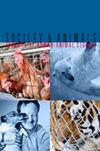Dogs Feared and Dogs Loved: Human-Dog Relations in the Late Ottoman Empire
IF 1
4区 农林科学
Q4 SOCIOLOGY
引用次数: 2
Abstract
The current study investigates human-animal relations with a specific focus on the case of dogs in the late Ottoman Empire. It contextualizes the new type of animal-human relations against the backdrop of the Ottoman modernization efforts, which took the form of institutional, legal, political and social reforms, and relates the adoption of dogs as pet (companion) animals to the global trends of keeping pets in Western Europe. In so doing, it scrutinizes the various religious, medical and professional perspectives concerning dogs and the human world in the late Ottoman Empire; the purchase and transfer of breed dogs from Europe and the middle classes’ responses to this new form of relationship; and finally, the dissemination of pet-keeping culture and practices among Ottoman upper and middle classes.狗怕狗爱:奥斯曼帝国晚期的人狗关系
目前的研究调查了人与动物的关系,特别关注奥斯曼帝国晚期的狗。它以奥斯曼现代化努力为背景,以制度、法律、政治和社会改革的形式,将新型动物与人类关系置于背景之下,并将收养狗作为宠物(伴侣)动物与西欧饲养宠物的全球趋势联系起来。在这样做的过程中,它仔细审视了奥斯曼帝国晚期关于狗和人类世界的各种宗教、医学和专业观点;从欧洲购买和转让品种狗,以及中产阶级对这种新型关系的反应;最后,在奥斯曼上层和中产阶级中传播宠物饲养文化和做法。
本文章由计算机程序翻译,如有差异,请以英文原文为准。
求助全文
约1分钟内获得全文
求助全文
来源期刊

Society & Animals
社会科学-兽医学
CiteScore
1.40
自引率
12.50%
发文量
46
审稿时长
>12 weeks
期刊介绍:
Society & Animals publishes studies that describe and analyze our experiences of non-human animals from the perspective of various disciplines within both the Social Sciences (e.g., psychology, sociology, anthropology, political science) and the Humanities (e.g., history, literary criticism).
The journal specifically deals with subjects such as human-animal interactions in various settings (animal cruelty, the therapeutic uses of animals), the applied uses of animals (research, education, medicine and agriculture), the use of animals in popular culture (e.g. dog-fighting, circus, animal companion, animal research), attitudes toward animals as affected by different socializing agencies and strategies, representations of animals in literature, the history of the domestication of animals, the politics of animal welfare, and the constitution of the animal rights movement.
 求助内容:
求助内容: 应助结果提醒方式:
应助结果提醒方式:


